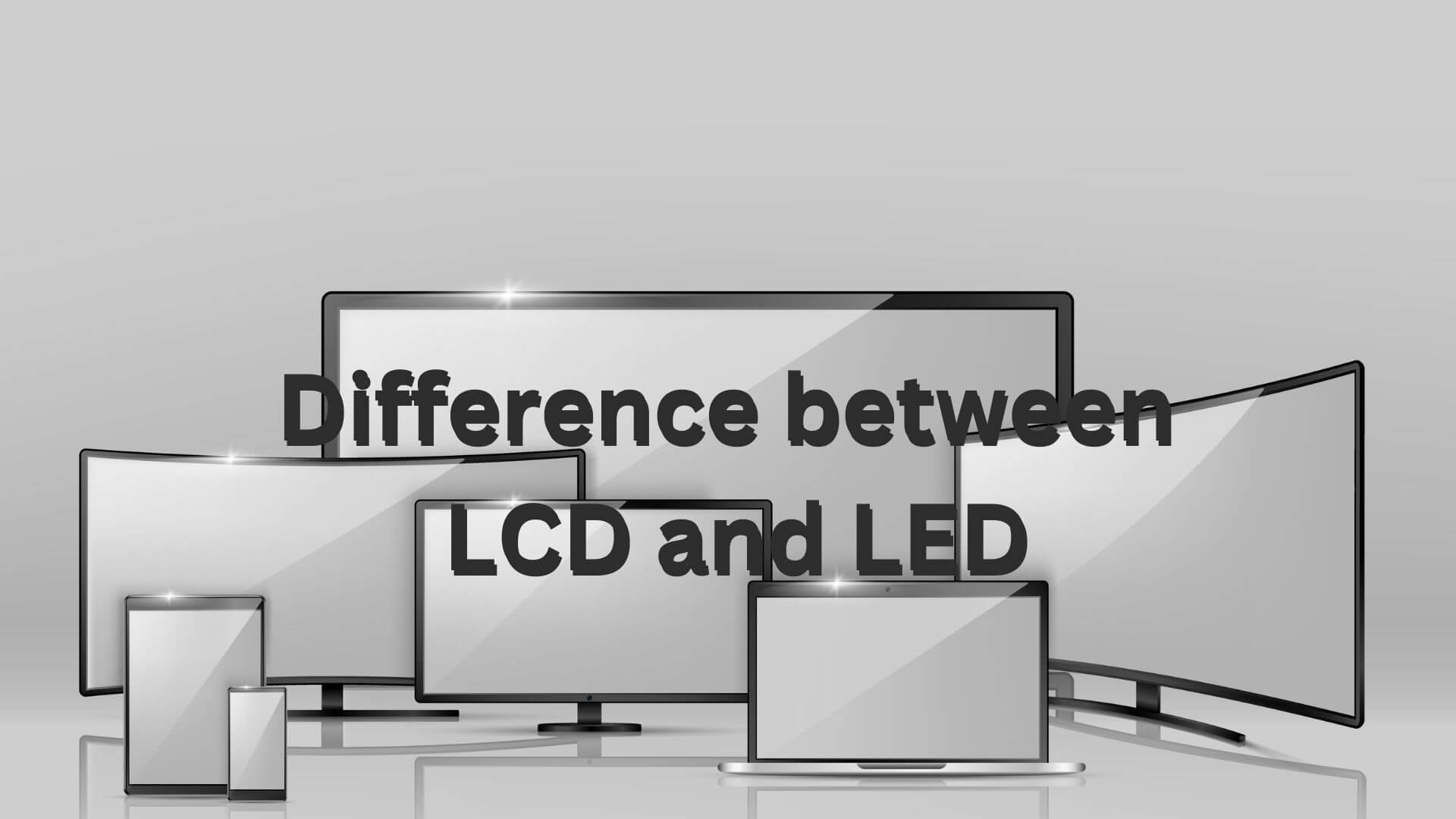Difference between LCD and LED
General
In this article we will understand the difference between LCD and LED. We aim to provide an in-depth introduction to LCD and LED displays. We will explain what LCD and LED displays are, how they work, and their respective advantages and disadvantages. Our goal is to equip readers with a comprehensive understanding of both display technologies and enable them to make informed decisions about which display technology best fits their needs.
Difference between LCD and LED
| LCD | LED |
| Liquid crystal display | Light emitting diode display |
| Uses a backlight behind the liquid crystal layer to create an image | Uses individual light-emitting diodes to create an image |
| Can have a limited viewing angle and color accuracy | Usually has a wider viewing angle and better color accuracy |
| Typically requires a backlight, which can be energy-intensive | Typically uses less energy and can offer greater energy efficiency |
| Can be affected by image retention and ghosting | Typically more durable and has a longer lifespan |
| Typically less expensive than LED displays | Usually more expensive than LCD displays |
Liquid Crystal Display (LCD)

An LCD display works by using liquid crystals that can manipulate light, either blocking or allowing it to pass through. A backlight is positioned behind the liquid crystal layer, providing illumination for the display. Electrodes are used to control the liquid crystals, activated by an electrical charge to determine the amount of light transmitted through the display. By controlling the light, an LCD display creates an image that is visible to the viewer.
Working Principle
The working principle of an LCD (Liquid Crystal Display) is based on the manipulation of light by liquid crystals. An LCD display consists of a layer of liquid crystals sandwiched between two transparent electrodes. The liquid crystals are controlled by an electrical charge that is applied to the electrodes, causing them to align in a specific way and either block or allow light to pass through.
A backlight is positioned behind the liquid crystal layer, illuminating the display. The amount of light transmitted through the liquid crystal layer depends on the electrical charge applied to the electrodes. A low electrical charge results in the liquid crystals blocking most of the light from the backlight, while a high electrical charge allows more light to pass through.
The electrodes are connected to a controller, which activates specific electrodes to produce a pattern of light and dark pixels. This pattern creates an image that is visible on the display. By controlling the amount of light transmitted through the liquid crystal layer,.an LCD display is able to produce an image.
In conclusion, the working principle of an LCD display involves controlling the alignment of liquid crystals with an electrical charge and using a backlight to illuminate the display, resulting in the creation of an image.
Advantages of LCD
We enumerate the advantages of LCD displays.
- Thinner and lighter: LCD displays are thinner and lighter. Compared to traditional CRT (Cathode Ray Tube) displays, making them more portable and easier to mount.
- Energy efficient: LCD displays consume less power. As compared to CRT displays and are more energy efficient. Making them an eco-friendly choice.
- Improved image quality: LCD displays produce sharp and clear images with good color accuracy and contrast. Making them ideal for a variety of applications.
- Wide viewing angle: LCD displays have a wide viewing angle. Which means that images remain clear and vibrant. Even when viewed from off-center.
- Versatile: LCD displays are versatile and can be used for a wide range of applications. Including televisions, computer monitors, laptops, and smartphones.
Disadvantages of LCD
We enumerate the disadvantages of LCD displays.
- Limited viewing angle: While LCD displays have a wider viewing angle compared to CRT displays. They still have a limited viewing angle, and images can appear washed out or distorted when viewed from extreme angles.
- Image retention: LCD displays can suffer from image retention. Where a faint ghost image is left on the screen after displaying a static image for an extended period.
- Motion blur: LCD displays can exhibit motion blur, where fast-moving objects appear blurred on the screen.
- Limited color gamut: While LCD displays have improved color accuracy and contrast. They still have a limited color gamut and may not be able to accurately reproduce certain colors.
- Response time: LCD displays have a slower response time compared to other types of displays. Which can result in visible image ghosting.
Light emitting diode display (LED)
.jpg)
We provide a definition of LED (Light-Emitting Diode) displays. LED displays are a type of display technology that uses tiny light-emitting diodes to produce an image. An LED display is essentially a flat panel display that uses an array of LEDs as its light source. Unlike LCD displays, which rely on a backlight to illuminate the display, LED displays use the light-emitting diodes themselves to produce an image.
In an LED display, each LED can be turned on or off independently, allowing for precise control of the brightness and color of individual pixels. This makes LED displays more versatile and capable of producing higher-quality images compared to LCD displays. Additionally, LED displays have a faster response time, lower power consumption, and longer lifespan compared to other types of displays.
Working principle of LED displays
LED displays work by using tiny light-emitting diodes as the source of light for the display. These diodes emit light when a current is passed through them and can be turned on and off individually, allowing for precise control of the brightness and color of individual pixels.
In an LED display, the LEDs are arranged in a matrix to form an array of individual pixels. The brightness and color of each pixel is controlled by a series of drivers, which regulate the flow of electricity to each LED. The drivers are connected to a control circuit, which is responsible for generating the image that is displayed on the screen.
The image is created by selectively turning on and off the individual LEDs, producing the desired brightness and color for each pixel. This allows for the creation of high-quality images with precise color control, making LED displays ideal for a variety of applications.
Advantages of LEDs
- LED displays deliver higher quality images than LCD displays, with improved brightness, color control, contrast, and color accuracy.
- LED displays boast a faster response time than LCD displays, which ensures that fast-moving images appear smoother and less blurred on the screen.
- LED displays consume less power than LCD displays, making them more energy-efficient and cost-effective to operate.
- LED displays have a longer lifespan than other types of displays, reducing the need for frequent replacements and lowering the overall cost of ownership.
- LED displays are thinner and lighter than other types of displays, making them more versatile and portable.
Disadvantages of LEDs
- Higher cost: LED displays tend to be more expensive as compared to LCD displays, which can make them less accessible for some users.
- Limited viewing angle: LED displays tend to have a more limited viewing angle compared to LCD displays, which means that the image quality can degrade if the viewer is not looking directly at the screen.
- Poor black level performance: LED displays can struggle to produce deep blacks, which can result in a less immersive viewing experience.
- Color uniformity issues: LED displays can suffer from color uniformity issues, where the color can vary across different areas of the screen.
- Complex manufacturing process: Leading to higher production costs. The manufacturing process for LED displays is more complex compared to other types of displays.
Similarities between LCD and LED
- Both LCD and LED displays have the ability to display high-quality images with good color accuracy and contrast.
- Both types of displays use a backlight to illuminate the image and create a clear and visible picture for the viewer.
- Both LCD and LED displays are constantly evolving and improving, with new advancements in technology helping to enhance the overall viewing experience. .
- Both LCD and LED displays use a backlight to create the images that are visible to the viewer.
- Both display technologies require careful consideration of factors such as budget, image quality, response time, power consumption, and lifespan to determine which one best meets the user's needs.
Conclusion
In conclusion, the choice between LCD and LED displays depends on the specific needs and requirements of the user. Both display technologies have their own advantages and disadvantages. Including factors such as budget, image quality, response time, power consumption, and lifespan. To make an informed decision, the user should carefully consider each of these factors. Determine which type of display best meets their needs.
